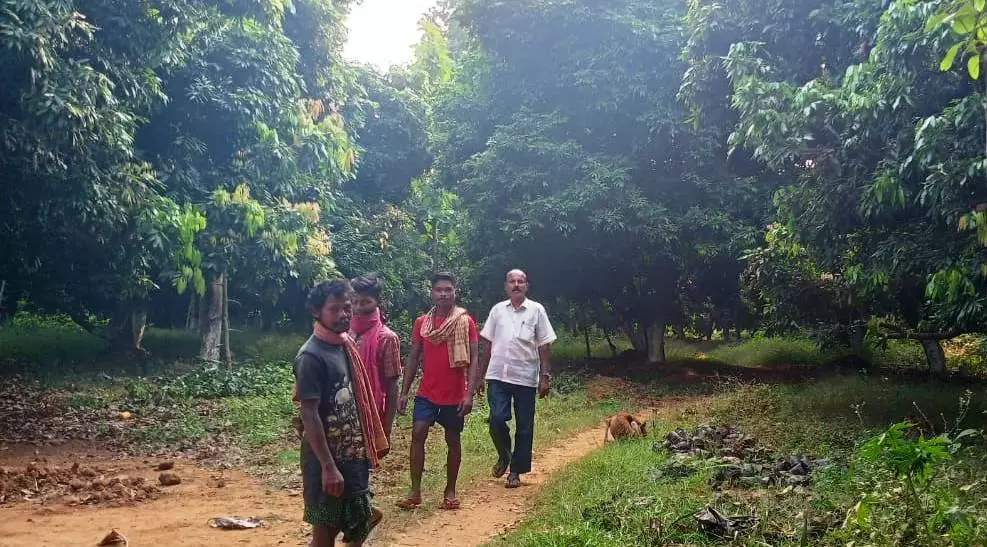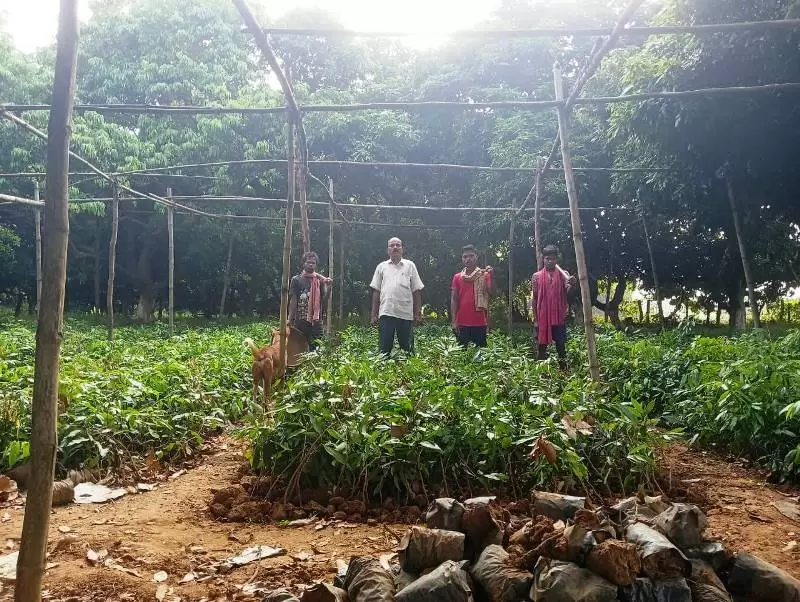Litchi Farmer in Odisha Earns Rs 21 LPA, Gives IT Professionals a Run for Their Money
Niroj Ranjan Misra
| Cuttack
30-November-2024
Vol 15 | Issue 48
Sexagenarian Netrananda Sahu, from village Kalla under Barkote block of Deoghar district in Odisha, is a bundle of energy in his litchi orchard, though his farming of the juicy fruit proves rough and tough.
For his 200 litchi plants spread across four acres alone fetch him about Rs 12 lakh every year, while paddy, mustard, and other crops grown on another seven acres bring in nearly Rs. 9 lakh per year.

| Netrananda (in the far background) with the workers at his litchi farm (Photos: Special Arrangement) |
Together, his total income of about Rs 21 lakh per year matches the salary of a Senior Project Manager at some top Indian IT companies.
Inspired and guided by Sushanta Dash, a former junior horticulture officer of Deoghar, Netrananda—fondly called "Netra" by his loved ones—ventured into litchi farming in 2003-04.

After his first harvest in 2010-11, he began modestly trading litchis in 2012-13. Today, the litchis he harvests each April and May outperform his other agricultural ventures in profitability.
“About 500 villagers in nearly 30 villages under Barkote and Teleibani blocks primarily grow litchi across 600 hectares in the district. While most of them are doing well, Netrananda is among 20 farmers in the district considered the most successful litchi farmers,” said Antarjyami Sahoo, the deputy director (horticulture), Deoghar.
“Netrananda purchased 200 litchi saplings at the subsidised rate of Rs 1 each from our farm in Barkote block headquarters, while a sapling cost Rs 10 in the open market at the time. The government had set the rate at Rs 1 to encourage villagers to take up litchi farming,” said Sushanta, who is now the deputy director (horticulture) of Gajapati district.
Though Netrananda’s litchi plantation began in July-August of 2003-04, it only started yielding fruit in 2010-11. Each plant in his field then produced 200 to 500 fruits. However, he distributed the fruit freely among people, hoping to create a viable market for his litchi.

| Workers collecting and bundling stalks laden with litchis |
He started trading modestly in 2012-13 when each plant began yielding 700 to 1,000 fruits. During this time, he sold litchi by the roadside along NH No.6 (now NH No.49) near his village, while continuing to distribute a portion of the yield for free.
Despite the challenges, he managed to earn Rs 50,000 to Rs 60,000 annually by selling a bunch of 100 fruit-bearing stalks at Rs 50 to Rs 60.
By 2016-17, when each plant began yielding 2,000 to 3,000 juicy fruits, he sold a bunch at Rs 70 to Rs 80, earning between Rs 1 lakh and Rs 2.5 lakh.
Yet, it required immense patience and perseverance, as a number of plants wilted, pest attacks reduced productivity, many fruits cracked while maturing, and birds such as owls and bats fed on them. These factors, according to him, caused an annual loss of about 20 percent of the yield.
“My real trade started in 2021-22, when a plant five to seven feet high yielded nearly 5,000 fruits and a plant 20 to 22 feet high produced 15,000,” said Netrananda. “I segregated the smaller fruits from the bigger ones. Now, I sell a bunch of 100 stems bearing smaller litchis at Rs 80 to Rs 100, while the bigger ones fetch Rs 120 to Rs 150. Besides, I also sell litchi saplings at Rs 40 each.
“I have grown plants of the Bombai, Muzaffarpur, and China varieties. I have 20 plants of the Bombai variety, 10 of the Muzaffarpur variety, and the remaining 170 are of the China variety in my orchard.
“Though the yield from each variety is almost the same, my customers prefer the China variety, as its ripe fruit is more reddish and tastier.”
Traders from places such as Rourkela, Sambalpur, Cuttack, and Bhubaneswar eagerly buy his litchis. Even traders from Bihar and Jharkhand, both known for their litchi farming, take his produce. Netrananda manages to sell off his entire litchi harvest within a fortnight.
However, farming is no easy task in Deoghar, especially until harvest time. Netrananda and his five workers have to irrigate the plants twice a week during summer and once a week in winter, though irrigation is rarely needed during the rainy season.
According to him, the most arduous part of the job is protecting the ripening fruit from birds. He and his workers must remain awake through the night, ringing bells and flashing lights on the plants to ward off the avian marauders.
“Another tough part is hiring 10 to 15 temporary workers during harvest time for plucking the fruit stalks, collecting, and tying them into bundles, especially as there is an acute shortage of workers in our village,” said Netrananda.

| Netrananda and his workers amidst litchi saplings |
“I pay Rs 250 daily to each of the five workers who manage my entire farming setup. I have also provided housing for them and cover their food and medical expenses. During harvest, I pay Rs 300 daily to each of the temporary workers.”
Netrananda has two children—a daughter and a son. He married off his daughter in 2022. “As my son never showed any interest in farming, I invested nearly Rs 50,000 to set up a shop selling dress materials in our village for him. However, I’ve never tried to enquire about how much he earns, because I have immense faith in myself and my farming,” he said.
“An average temperature of 30-35 degrees centigrade is ideal for litchi cultivation, which is prevalent in around 30 villages where litchi farming has been adopted,” said deputy director (horticulture) Antarjyami.
“While sandy loam soil is best suited for litchi farming, the clayey soil in village Kalla can also yield good results if farmers follow proper farming techniques. Unfortunately, most farmers are lax in adhering to scientific methods, whereas Netrananda follows them to the letter with relentless effort, even in the evening of his life.”
Netrananda also expresses gratitude to the Deoghar-based Krishi Vigyan Kendra (KVK), a wing of Odisha University of Agriculture and Technology, Bhubaneswar, for their guidance. KVK regularly educates farmers on scientific methods of plant, pest, and disease management.
The recommended distance between two litchi plants is usually 20 to 30 feet, and Netrananda has maintained a 25-foot gap between his plants. After every harvest, he ensures the plants are pruned, which helps maintain consistent annual yields.
He applies pesticides at the right time to prevent pests such as the ‘fruit-and-shoot borer’ from attacking the plants when flowers are about to turn into fruit. Similarly, he uses fungicides to prevent diseases like Cephaleuros virescens during the rainy season, according to Dr Sabyasachi Sahoo, KVK’s subject matter specialist in Deoghar.

| A litchi tree bursting with fruits |
Although Netrananda has studied only up to the upper primary level, he has gained extensive knowledge of litchi farming through experience and regular interactions with officials from the horticulture department and scientists from KVK.
About 22 farmers from different villages near Kalla, who have purchased saplings from him to start litchi farming, frequently seek his guidance.
“Last year, I bought 300 saplings from Netra to grow litchi on my five acres, but I often seek his advice,” said Tulan Sing, a farmer from Laimura village, located about 50 kilometres from Kalla.
“Netra is so sincere and meticulous in his farming and so knowledgeable about it that he tops the list of nearly 15 farmers cultivating litchi on about 25 acres in his village,” he added. - ©TWL
















